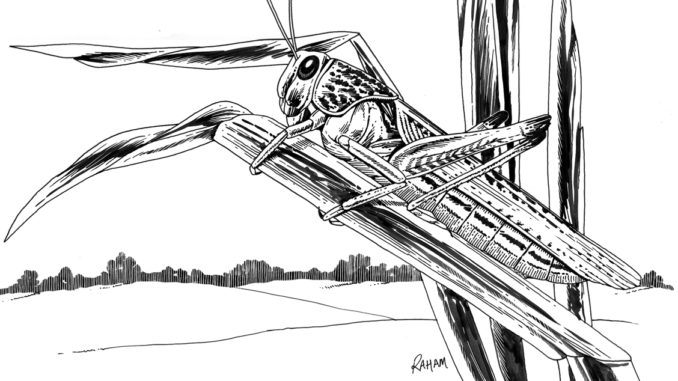
By R. Gary Raham
North Forty News
An article in the August 31 issue of Science by C. A. Deutsch predicts that a warming climate will crank up insect metabolism, especially in what are now temperate crop-producing regions of the world. Insect pests currently skim off 8% of the world’s maize and wheat crops each year and 14% of rice. Deutsch’s mathematical model predicts that for every 1 degree Celsius rise in temperature insects will munch on an extra 10-25% of wheat, maize, and rice. Insects possess a “cold-blooded” metabolism that ramps up as temperature increases. Mammals and birds keep their metabolic furnaces fired up at a constant rate regardless of temperature.
Local Colorado State researchers tackle similar questions about the impact of a warming climate on prairie ecosystems at the Smith Lab, headed by Melinda D. Smith, Professor of Ecology and Evolutionary Biology. Nathan Lemoine, a Post-doctoral Associate there, has co-authored papers that demonstrate some of the complexities of plant-animal associations as climate warms. While Lemoine feels that Deutsch’s paper provides a solid first step in understanding future impacts of insects on food crops, Lemoine’s own work hints at some of the other complications induced by warming annual temperatures.
For example: Warming temperatures have direct effects like increasing both plant growth rates and higher metabolic rates in insect plant eaters. To some extent, these trends offset each other. Warming also tends to affect a plant’s ability to produce chemical defenses and impacts plant seed production. Indirect effects of warming include changes in how plants and insects interact. Lemoine’s work shows that some of these interactions—like how much insects dine on their food supplies—are not as intuitive as one might think.
In a paper last year in the Journal Ecology (https://esajournals.onlinelibrary.wiley.com/doi/full/10.1002/ecy.1855http://(https://esajournals.onlinelibrary.wiley.com/doi/full/10.1002/ecy.1855), Lemoine’s work showed that plants can compensate for herbivory (insect munching) at normal temperatures by not growing as much and producing fewer fruits—but fruits with more seeds per fruit. “As a result,” Lemoine said on his website last year (www.natelemoine.com), “total seed biomass was unaffected by insects (although seeds were smaller).”
He goes on to say, “Warming changed all that. Plants were shorter and they produced more fruits. However, fruits were smaller, and packed with many small seeds. It was quite astonishing, however, because herbivores no longer had any effect. Despite high leaf damage, plant life history was unaffected by the presence of herbivores.” In other words, insects didn’t alter the plants’ ability to flower and set seeds effectively.
Lemoine speculates that increased warming reduced soil moisture, which induced a stress response leading to stunted growth and altered plant life history. While Lemoine’s study only looked at one plant-insect relationship, it points to the fact that ecological relationships represent complex interactions that evolve over long periods of time. A warming climate will change the insect-plant dynamic for many species—perhaps in surprising ways. It’s good that we have an educational institution close by that is exploring these changes before some of those surprises turn out to be too unpleasant.
Support Northern Colorado Journalism
Show your support for North Forty News by helping us produce more content. It's a kind and simple gesture that will help us continue to bring more content to you.
BONUS - Donors get a link in their receipt to sign up for our once-per-week instant text messaging alert. Get your e-copy of North Forty News the moment it is released!
Click to Donate
